Has there ever been a plant that looked (and sounded) so luxurious as the Pearls and Jade Pothos?
Named after its muted forest green and dazzling off-white tones, which bear resemblance to precious gemstones – this plant is the height of fashion.
But, while pearls and jades are classic pieces, the Pearls and Jade Pothos is a hot new trend.
Produced by the University of Florida, it’s one of the most recent Epipremnum aureum cultivars, only entering the houseplant scene officially in 2008 when it snatched its patent.
In this short time, this plant has earned its status as an adored and valued Pothos cultivar.
With the relaxed care requirements of a Golden Pothos and all the beauty of a haute variegated Monstera (minus the eye-watering price tag), it’s a trend you’ll want to jump on!
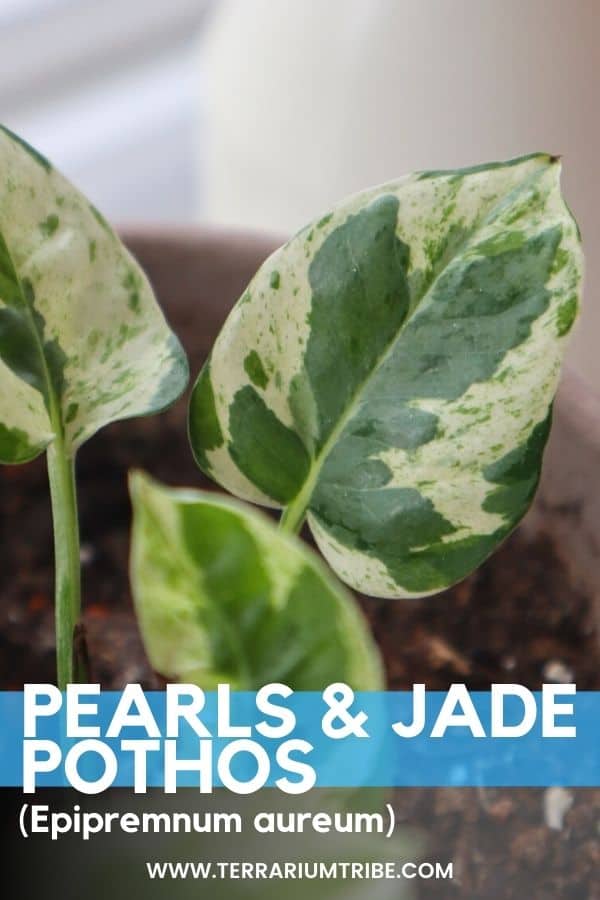
How to Identify the Pearls and Jade Pothos
If you’re a hardcore Pothos fan like me, you might know that it’s one of several cultivars of Pothos that appear indistinguishable to the untrained eye.
Even a quick trip down Google Image Lane will see plants clearly mislabelled, and it’s somewhat understandable.
The Pearls and Jade, Njoy, and Glacier all have green/cream/white variegation and show off beautiful blotched variegation patterns, and sometimes flecked variegation too.
What makes our darling P&J stand out from the rest, however, is it’s the only one of these copycat varieties that boasts speckled green-on-green variegation.
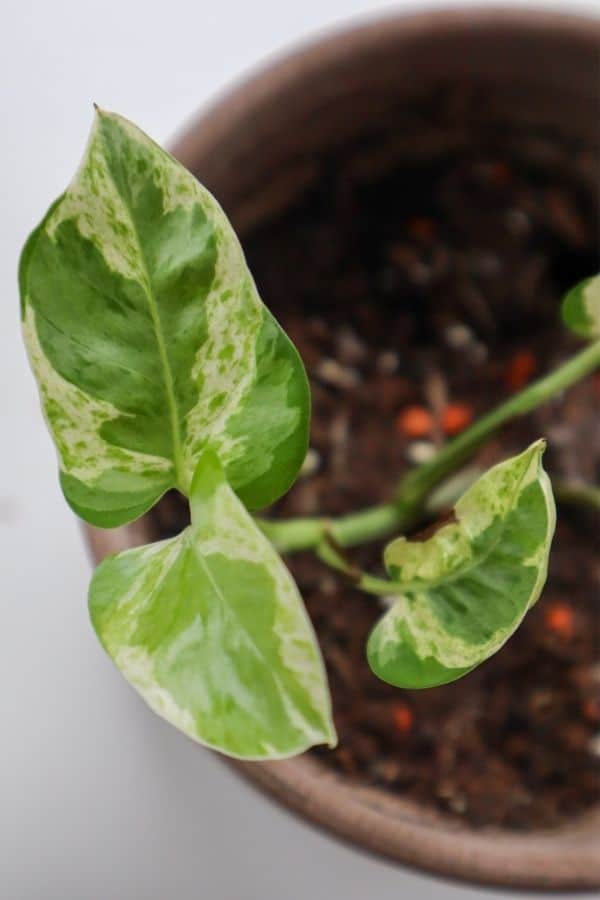
Now we’ve cleared that up, let’s get into the care guide!
Where to Buy the Pearls and Jade Pothos
See the links below to purchase from reputable terrarium plant shops and marketplaces (may include affiliate links).
Pearls and Jade Pothos Care & Growth
At a Glance
| Plant Type | Vine |
| Lighting | Bright indirect light |
| Temperature | 55-95°F (13-35°C) |
| Watering | Moderate even watering |
| Humidity | 60-90% humidity |
| Growth | 1ft+ semi-vining |
Lighting
Generally speaking, when it comes to the hardy Pothos family, you have a fair bit of wiggle room with light conditions.
After all, while the Pearls and Jade is a new cultivar, its parent plant (the Marble Queen Pothos) is an invasive species and an unstoppable grower in the wild.
But, either extreme in the home could spell a plant disaster:
- Too little bright light – and you’d see stunted, slow growth and potentially lose some of the yummy creamy variegation if the plant struggles to photosynthesize.
- Too much direct light – and the leaves could scorch (though it’s important to point out that it depends on how intense the sun is where you’re situated – I live in the North-East UK, and I’ve never had any issues with Epipremnum in direct light).
If you want to go the extra mile for your plant, however, bright indirect light is the gold standard.
This means a spot where the plant gets plenty of light but without any direct rays from the sun. An easy way to identify bright indirect light is that you can’t see any harsh shadows on the walls.
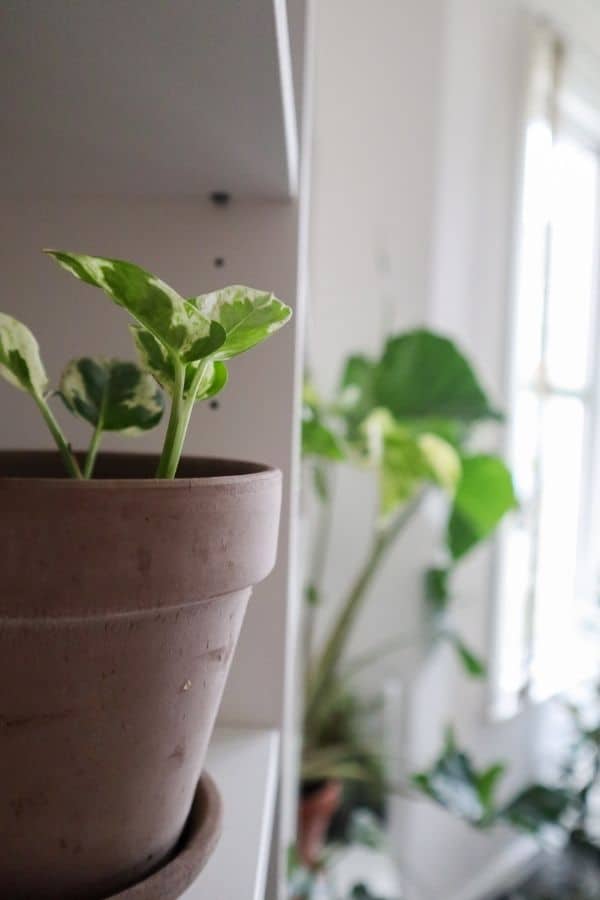
Watering
How frequently your Pearls and Jade needs a watering can vary by so many factors (season, temperature, pot size, etc).
So, the best way to know your plant needs a drink is simply by feeling the soil.
When the soil is feeling a little dry to the touch, give it a good soak until you see water coming into the drainage tray, tip away the excess and then wait until it’s feeling dry-ish before you water again.
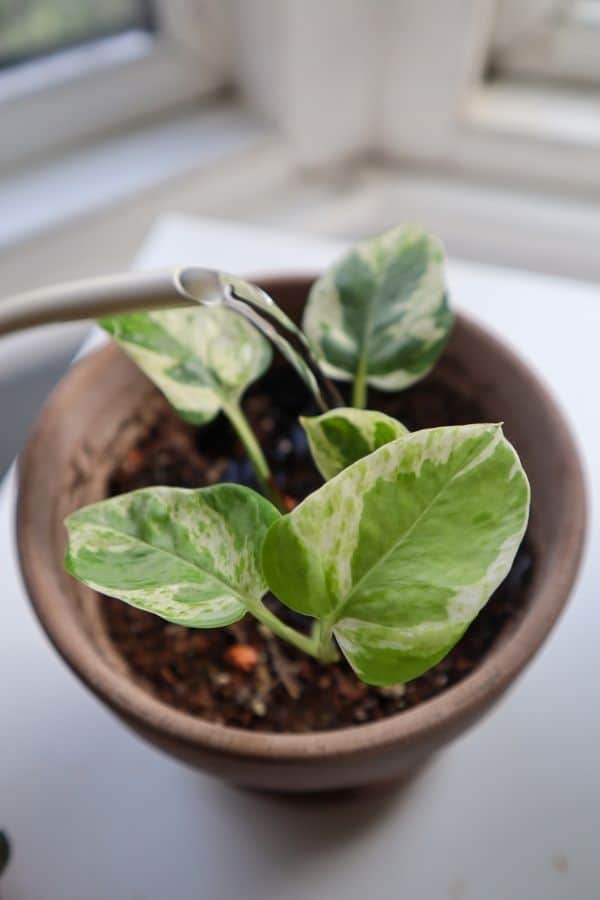
Oh, and did I mention… Pots with drainage holes are a MUST for happy tropical plants; they prevent root rot by ensuring the plant isn’t sat in soggy soil.
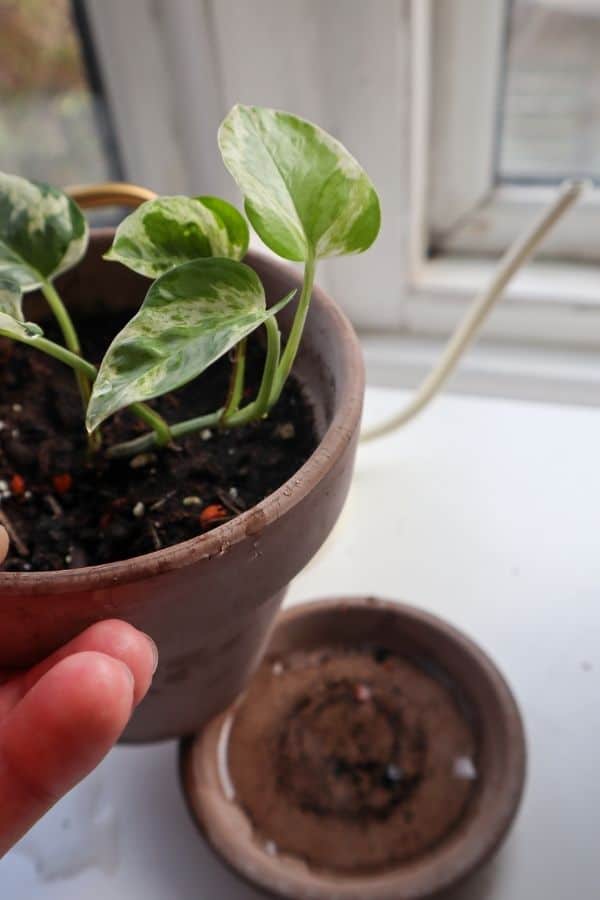
In a terrarium, using a drainage layer – or false bottom – is the vital equivalent and will give any excess water somewhere to collect out of harm’s way of your healthy roots.
And go easy on the water! It’s easy to add and difficult to remove.
Substrate / Soil
Overall, Pothos are very forgiving plants, and that applies to what they’re growing in, too.
Though they will grow in most typical substrates, I’d always recommend you go for something that mimics their natural environment better than the likes of standard potting soil/compost (this is critical in a terrarium).
Something that holds moisture well but still drains effectively.
The Pearls and Jade Pothos will thrive in an aroid mix.
Look to find (or make) a mix with plenty of chunky aeration elements (e.g. orchid bark or pumice). That’ll ensure the plants’ roots have lots of airflow and oxygen.
Temperature & Humidity
As I told you earlier, the Pearls and Jade is a Floridian – making a Floridian environment just perfect for this plant.
Which (anyone who’s stepped off a plane at Orlando International Airport will tell you) is hot and humid.
But I wouldn’t worry too much, you won’t need to turn your home into a swamp! It’s still a relatively unfussy Epipremnum aureum at the end of the day.
For temperature, anything in the 55-95°F (13-35°C) region is great.
And when it comes to humidity, it’ll be happy with anything over 60%. Pretty standard for our aroid pals, right?
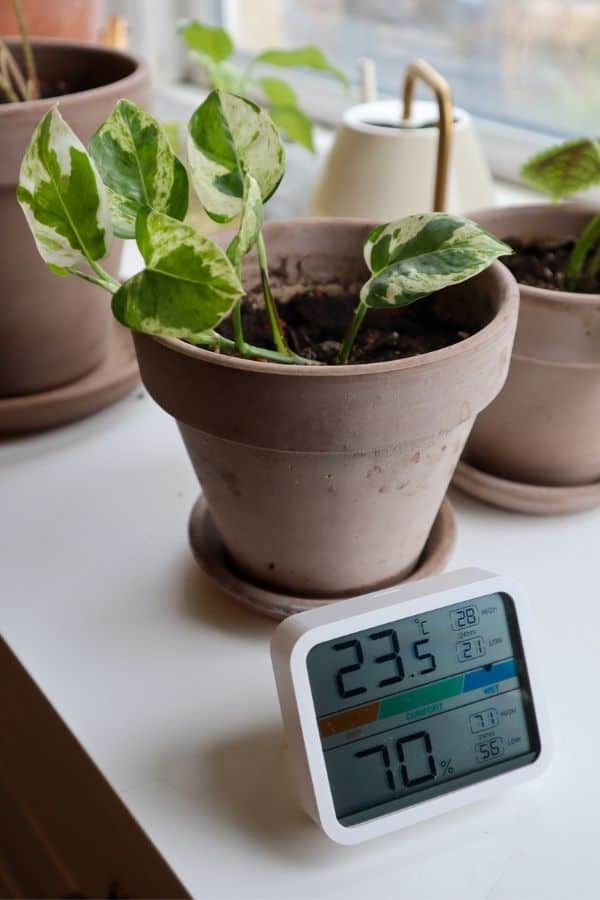
My favorite hack for boosting humidity is leaving watering cans around the room for the water to evaporate – no costly solutions necessary!
Growth
If you enjoy a fuller-looking plant, or you want a Pothos that’s a great fit for a terrarium, the Pearls and Jade is the one for you!
Because of its short internodes (the length of stem between two leaves), it has a compact growth habit compared to some other Pothos cultivars, giving it a much bushier look.
Not only that, but its leaf size is usually much smaller than other varieties.
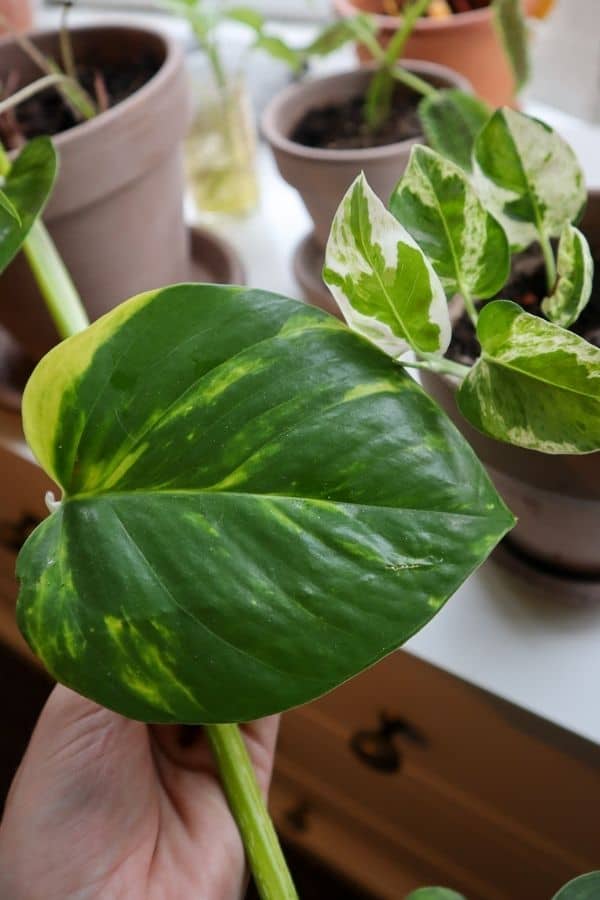
I say usually because I’ve seen some mature plants on moss poles with bigger leaves, but I imagine it takes quite a bit to get them to that size, and most I’ve seen are gorgeous and dainty.
After all, it’s still a tropical vine, so we rarely get to see them in their full glory as indoor plants.
Propagation
Pothos plants are extremely simple to propagate, and I find they take so little time to root compared to Philodendron.
Grab a pair of clean scissors and snip each leaf node, leaving about a quarter of an inch of stem on both sides and then pop your stem cutting in water. That’s it!
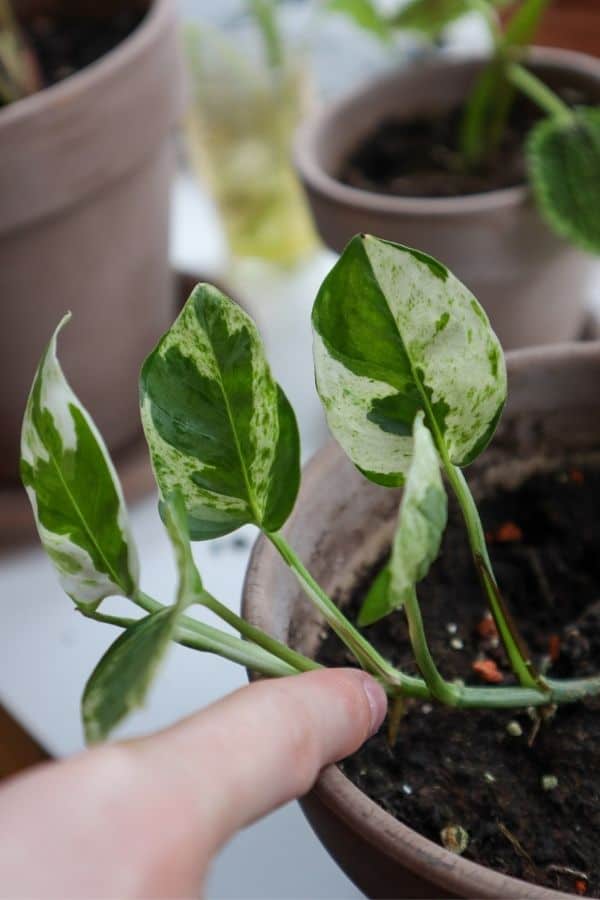
In just 3-5 weeks, your cutting will be rooted and ready to plant up. YAY!
Put it in your latest terrarium project, give it to a friend, or plant it back in the mother plant if you like an even fuller-looking plant.
Varieties & Similar Plants
Shiny object syndrome? No problem! There are more than enough varieties of Pothos available to keep you entertained for quite a while.
I’m currently the proud owner of no less than seven plants, and my collection has a way to go before it’s complete.
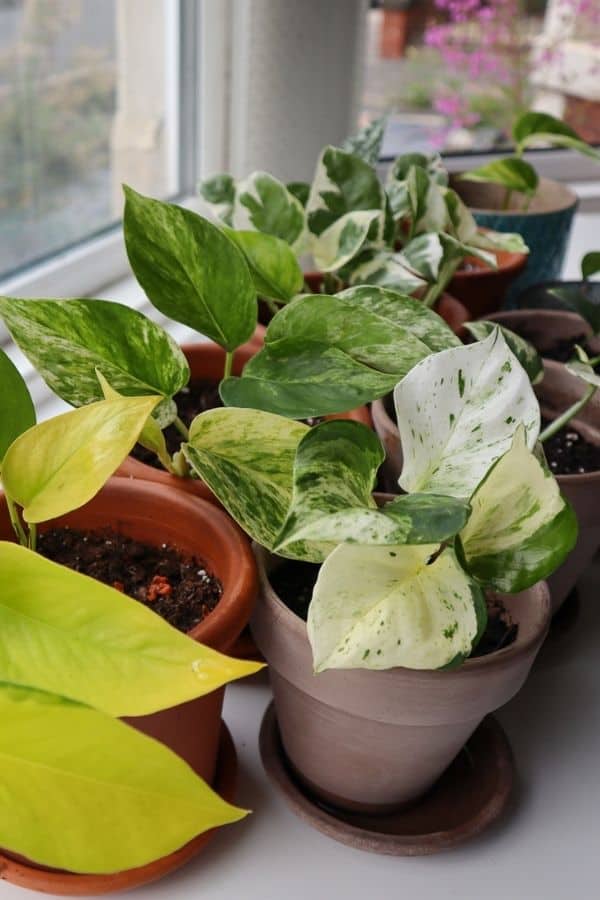
You can see my full breakdown of each and every Pothos variety here.
Or, if you’d rather dive in more extensively, you can head to our other cultivar-specific plant profiles:
Let the obsession… commence!
In all honesty, though, pearls and jades are so timelessly fashionable that they’ll go with just about anything!
Frequently Asked Questions
The Njoy Pothos is quite similar to the Pearls and Jade. They both have small, irregular-shaped leaves with blotched variegation and short internodes. You can tell them apart because the P&J has an extremely speckled variegation pattern on top of the blotches – both green on green and green on white. The Njoy, however, may have some green on white speckles but doesn’t have any green on green.
The Pearls and Jade and the Manjula Pothos are quite easy to tell apart when you know what to look out for. The Manjula has bigger, broader, heart-shaped leaves, whereas the P&J has more ovate-shaped leaves. While both have blotches of green variegation, the Manjulas tend to be focused on the edges of the leaf, as opposed to the middle with the P&J.
